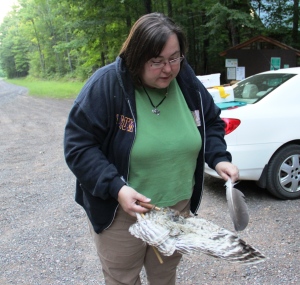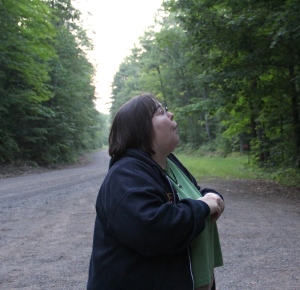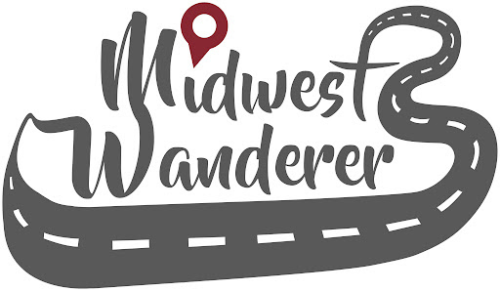Our itinerary instructions said to meet at the North End Trailhead at 8 p.m. to call in barred owls. If it was October, there would have been an element of Halloween eeriness about it, driving down dark, silent North Wisconsin forested roads, meeting an owl caller who attracts birds of prey. My imagination could run wild with that. But it was July and still light as we made our way to the meeting place following maps and signs. The GPS wouldn’t do for this destination.
Don’t miss a Midwest Wanderer post. For a FREE subscription, enter your e-mail address in the Subscribe2 box to the left and click Subscribe.
Skip and I met Susan Thurn, a naturalist formerly with the nearby Cable Natural History Museum and expert barred owl caller, accompanied by Emily Stone, the museum’s current naturalist. A newlywed couple on their honeymoon were the other participants in the evening’s activity.
Before the calling began, Susan shared some interesting facts about barred owls:
- They can’t move their eyes in their eye sockets
- They have extra vertebrae in the neck and can turn their neck 270 degrees
- If they could read, they’d be able to read a newspaper from across a football field
- Human eyes would have to be the size of grapefruit to see as well
- Barred owls nest in tree cavities or in old nests of hawks or crows
- They breed once a year, in February or March
- Males weigh on average 1.5 pounds, and the females average 2 pounds.
- The weight is mostly feathers
- Wingspan is about 38 to 42 inches
Susan demonstrated how the soft, feathered edges of the owl’s wings dampen the sound made from flapping wings.
 We also passed around an owl talon and an owl pellet. Owls eat small prey whole and then regurgitate non-digestible parts. The pellets are usually bones covered with fur.
We also passed around an owl talon and an owl pellet. Owls eat small prey whole and then regurgitate non-digestible parts. The pellets are usually bones covered with fur.
 Although there are several kinds of owls that make the Wisconsin Northwoods their home, we would be calling only barred owls.
Although there are several kinds of owls that make the Wisconsin Northwoods their home, we would be calling only barred owls.
Susan has the sound of the barred owl down pat. She once used a machine that compared her call to the call of a barred owl, and it match almost perfectly. You can hear a barred owl sound (click to listen) on Learner.org’s online Owl Dictionary. It sounds kind of like “Who cooks for you? Who cooks for you all?”
We learned the sound together as a group and then stayed completely silent while Susan called an owl. She said they don’t always call back; it depends on how close by they are. When they do call back, they may actually come closer, to protect their territory, or move farther away, to leave another owl’s territory.
 Silently we listened as Susan called, “Hoo hoo hoo hoooo, hoo hoo hoo hooo.” Silence, She called again. This time we heard an answer. “Hoo hoo hoo hoooo, hoo hoo hoo hoooo.” Susan called again, and we got another answer. This went on for a couple of minutes, each time the owl sounding farther away. Susan says she always lets the owl “win” by ending her calls before the owl does.
Silently we listened as Susan called, “Hoo hoo hoo hoooo, hoo hoo hoo hooo.” Silence, She called again. This time we heard an answer. “Hoo hoo hoo hoooo, hoo hoo hoo hoooo.” Susan called again, and we got another answer. This went on for a couple of minutes, each time the owl sounding farther away. Susan says she always lets the owl “win” by ending her calls before the owl does.
By the time we left, night was falling. Even though it was nowhere near autumn, a bit of Halloween eeriness was in the air in the dark forest that was once again completely silent.
Owl Prowls, held about four times each year, are one of many events sponsored by the Cable Natural History Museum, Cable, Wisconsin. Donations are welcome from event attendees.
Disclosure: Our trip to northern Wisconsin was hosted by the Wisconsin Department of Tourism, but any opinions expressed in this post are my own.
Thank you for reading Midwest Wanderer. Don’t miss a post. Enter your e-mail address below and click Subscribe to be notified whenever I publish another post. Subscription is FREE. After subscribing, be sure to click the link when you get the e-mail asking you to confirm. – Connie
